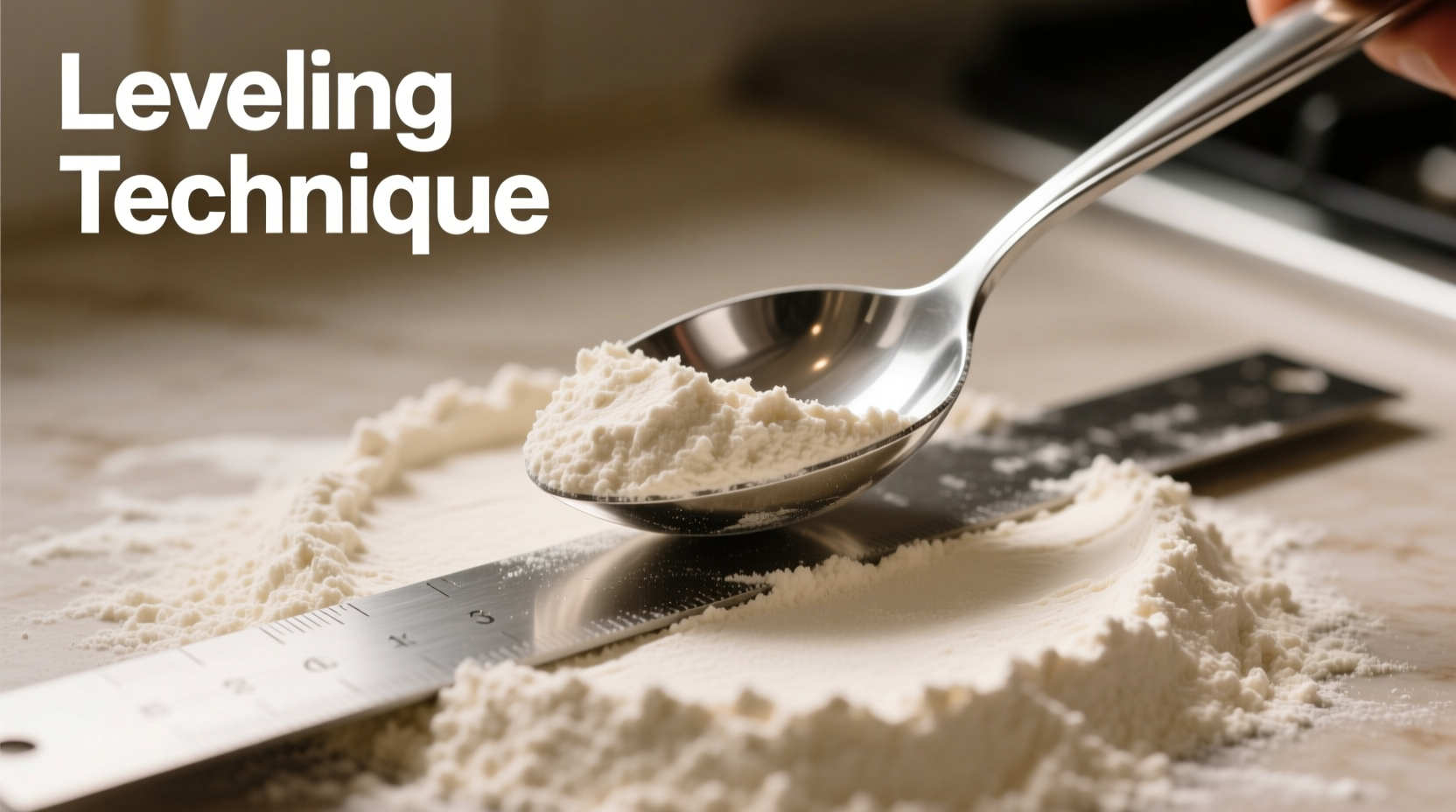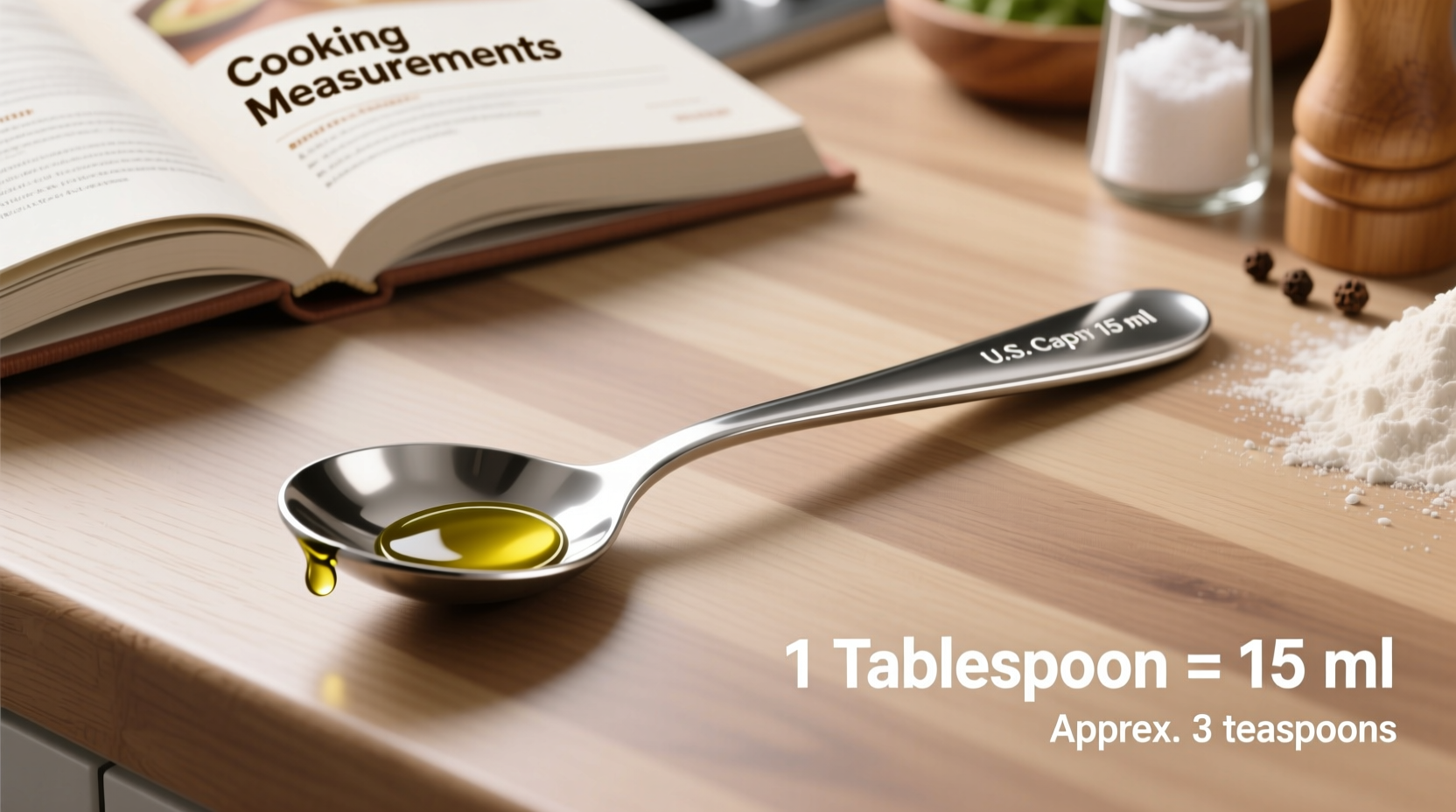What Exactly Is a Tablespoon in Cooking?
When you see "1 tablespoon" in a recipe, you're looking at a precise measurement unit, not just any spoon from your drawer. In culinary terms, a tablespoon (abbreviated as tbsp or Tbsp) represents 15 milliliters of volume in the metric system and most modern recipes. This standardized measurement helps ensure consistent results whether you're baking cookies or making salad dressing.
Understanding the tablespoon measurement prevents common cooking mistakes that happen when home chefs use random spoons from their cutlery set. Proper measuring spoons have flat rims that allow you to level off ingredients for accuracy—a critical detail when following recipes that require precision.
Global Tablespoon Standards Compared
| Country/Region | Tablespoon Volume | Teaspoon Equivalent | Fluid Ounce Equivalent |
|---|---|---|---|
| United States | 14.8 ml (rounded to 15 ml) | 3 tsp | 0.5 fl oz |
| United Kingdom | 17.7 ml | 3.5 tsp | 0.6 fl oz |
| Australia | 20 ml | 4 tsp | 0.7 fl oz |
| Metric Standard | 15 ml | 3 tsp | 0.5 fl oz |
This comparison comes from the National Institute of Standards and Technology's measurement guidelines, which standardize cooking measurements internationally. When following recipes from different countries, recognizing these variations prevents measurement errors that could ruin your dish.
Why Tablespoon Precision Matters in Your Kitchen
While some cooking allows for improvisation, certain recipes demand tablespoon accuracy. Baking in particular requires precise measurements because chemical reactions between ingredients affect texture and rise. A tablespoon too much baking powder can cause cakes to collapse, while insufficient leavening creates dense results.
Professional chefs like those trained at the Culinary Institute of America emphasize that consistency in measurement directly impacts recipe reproducibility. When you measure correctly using standardized tablespoons, you'll achieve the same results every time you prepare a favorite dish.

Essential Tablespoon Conversions for Everyday Cooking
Master these fundamental conversions to navigate any recipe confidently:
- 1 tablespoon = 3 teaspoons
- 2 tablespoons = 1 fluid ounce
- 16 tablespoons = 1 cup
- 3 teaspoons = 1 tablespoon = 15 ml
- 1/16 cup = 1 tablespoon
These conversions follow the USDA FoodData Central measurement standards used by nutrition professionals and recipe developers. When scaling recipes up or down, these relationships help maintain proper ingredient ratios.
Measuring Tablespoons Correctly: Professional Techniques
How you measure matters as much as what you measure. Follow these chef-recommended practices:
Dry Ingredients
Spoon dry ingredients like flour or sugar into your tablespoon measure, then level off with the straight edge of a knife. Never pack dry ingredients unless the recipe specifically states "packed tablespoon." This technique prevents over-measuring, which can ruin baked goods.
Liquid Ingredients
Place your tablespoon measure on a flat surface and pour liquid until it reaches the brim. View at eye level to ensure accuracy—holding the spoon in the air creates measurement errors due to perspective.
Sticky Ingredients
For honey, molasses, or peanut butter, lightly coat your tablespoon with cooking spray first. This prevents sticking and ensures the full amount releases into your mixing bowl.
When Precision Matters Most
Not all cooking requires exact tablespoon measurements. Understanding context boundaries helps you determine when to measure precisely:
- Critical precision needed: Baking, canning, cocktail mixing, and sauce making where chemical reactions or preservation depend on exact ratios
- Flexible measurements acceptable: Stir-fries, soups, and salad dressings where taste adjustments happen during cooking
- Never approximate: Recipes with leavening agents (baking powder/soda), yeast breads, and candy making
According to research published in Journal of Culinary Science & Technology, measurement errors exceeding 10% significantly impact baking outcomes. When working with tablespoons in critical recipes, use proper tools rather than estimating.
Common Tablespoon Measurement Mistakes to Avoid
Even experienced cooks make these measurement errors:
- Using dinnerware spoons: A typical soup spoon holds 10-15ml, creating inconsistent results
- Heaping when leveling required: "Tablespoon" means level unless specified as "heaping tablespoon"
- Measuring over the mixing bowl: Spills create inaccurate measurements—measure over counter first
- Using liquid measures for dry ingredients: Dry and liquid measuring tools serve different purposes
Fix these issues by keeping dedicated measuring spoons in your kitchen toolkit. Quality sets from brands like OXO or KitchenAid provide durable, accurate tools that withstand regular use.
Tablespoon Through History: A Brief Timeline
Understanding measurement evolution helps appreciate modern standardization:
- 1700s: "Tablespoon" referred to actual serving spoons, varying by household
- 1896: Fannie Farmer's Boston Cooking-School Cook Book introduced standardized measurements
- 1959: US standardized tablespoon as 1/2 fluid ounce (14.8ml)
- 1970s: Metric system adoption established 15ml as international standard
- Today: Most cookbooks use 15ml as standard tablespoon measurement
This historical progression from arbitrary to precise measurements reflects cooking's evolution from art to science, documented by culinary historians at institutions like the International Association of Culinary Professionals.
Practical Tablespoon Applications in Real Cooking
Apply your tablespoon knowledge with these everyday examples:
- Salad dressing: Classic vinaigrette uses 3 parts oil to 1 part vinegar (3 tablespoons oil + 1 tablespoon vinegar)
- Cookie dough: Drop cookies typically use 1-2 tablespoon portions for consistent baking
- Sauce thickening: 1 tablespoon cornstarch + 1 tablespoon cold liquid thickens 1 cup sauce
- Spice blending: Start with 1/2 to 1 tablespoon spices per pound of meat
These practical applications demonstrate why understanding tablespoon measurements transforms recipe following from guesswork to reliable technique.











 浙公网安备
33010002000092号
浙公网安备
33010002000092号 浙B2-20120091-4
浙B2-20120091-4